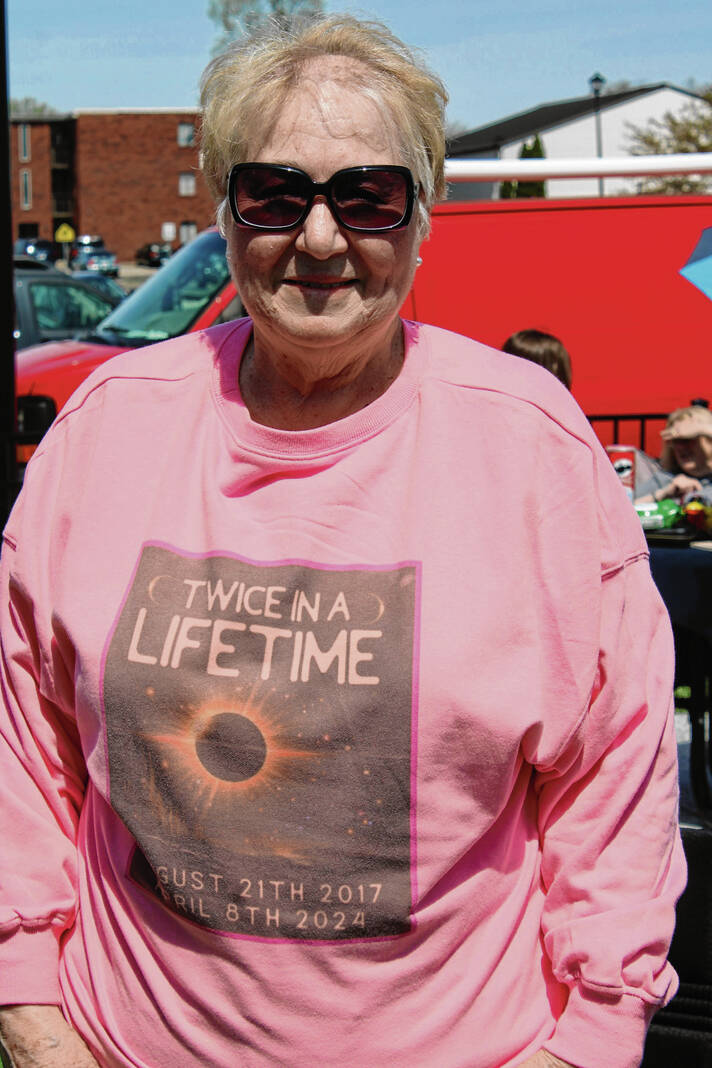
Betty Ryan of Chicago was part of a group of four showing of their “Twice in a Lifetime shirts” advertising that they watched the 2017 eclipse together, as well as this one in Seymour.


Hicks, a dog from Louisville, somewhat reluctantly wore his eclipse glasses.
As the moon completed its rare and irregular journey between the earth and the sun Monday afternoon causing the planet’s warming star to vanish completely in a stunning celestial display, one voice exclaimed, “There it goes.”
The sun and natural daytime light disappeared at 3:06 p.m., fooling downtown streetlights to twinkle on as if it was the middle of the night.
The Great American Eclipse had come to town bathing Seymour in a coveted path of totality, the likes of which will not be seen again in south central Indiana again until 2099.
It was enough of an occasion for astronomy appreciating Americans, who were not among the 32 million Americans who lived in the 100% blackout zone to make elaborate plans to see it all, perhaps for once in a lifetime.
About 25 eclipse lovers who could not resist the temptation to gaze at the heavens through special protective eyeglasses between 1:49 and 4:30 p.m. accidentally on purpose alighted on the grass in the small park beneath the John Mellencamp mural.
For some, partially because Seymour is situated close to where relatives live in Louisville, and partially because they are fans of Mellencamp’s music, they established their own little camp in the shadow of the popular mural.
“We’re a Mellencamp cult,” joked Lori Sichtermann, one of a gang of six of many ages, children included, from Munster in the northwestern part of the state and not in the path of totality and Charlotte, North Carolina.
Maybe the Rock and Roll Hall of Famer would show up to share quality eclipse time with them? Waiting for Mellencamp. She deadpanned, “We come every week.”
Those who stumbled on the mural park were quite pleased at their eclipse viewing location. It came complete with tables, though some visitors carried their own folding chairs. The sun was bright and strong, with the temperature climbing into the 70s until the eclipse action began and cooled the air.
Husband and wife Carol and Herb from Savannah, Georgia, in the retirement zone of age, rendezvoused with son Chris from Louisville, who brought his dog Hicks, a Papillon Pomeranian, who had his own eclipse glasses.
Two couples in their seventies from Chicago, Larry and Betty Ryan and Loretta and Patrick Cornfield, together watched the 2017 eclipse — the last big deal American show of this kind, in Missouri.
One family of four showed up with two daughters pulled out of school for the day, but who were watching the clock as well as the sky so they could rush to the Louisville airport after the sun and moon danced their duet. That way the kids could get back to school in Atlanta a day later.
“It’s such a cool thing,” mom Amity Dey said. “It’s totally worth it.”
One thing about eclipses: They follow their prescribed schedule. No one can bank on clear weather, but the moon is going to move on its trajectory regardless. As it so happened, the weather cooperated to the fullest.
At 1:49, a glance through special eclipse glasses allowed viewers to see the sun shrink, little by little. As Betty Ryan noticed, it was almost as if everyone was watching a game of Pac-Man, with increasingly large bites being hacked off the sun. Or if Hicks was snacking on a cookie one chew at a time.
The sun diminished from a full circle to a crescent, the orange still startlingly bright, until 3:06 p.m. when the moon swallowed it up. However, since the sun is so much larger, a white circular glow, or halo, remained visible, the corona. Vivid in a totally different manner than the sun’s natural hue, the whiteness gripped the onlookers.
Lillian, 11, of the Munster group, said the corona was the best part. She was not old enough to even know Corona is a beer, whereas in 2044 when another eclipse touches part of the U.S, in Montana, North Dakota and South Dakota, she will be old enough to drink one.
If she shows up. the Ryans and Cornfields will be in their 90s by then, yet they hope they can make one last eclipse journey in 20 years. The foursome displayed sweatshirts made for this excursion reading, “Twice in a lifetime.”
When the sun began expanding in view all over again and the streetlights clicked off, they replicated a toast they made to the eclipse in Missouri, They hope to hit the Badlands in 2044 showing off “Thrice in a Lifetime” tops.
Maybe by then Sichtermann and her family will have bumped into Mellencamp his own-self at the Mellencamp mural.
